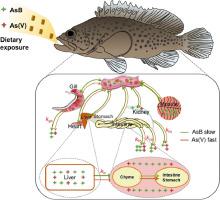Aquatic Toxicology ( IF 4.5 ) Pub Date : 2021-10-10 , DOI: 10.1016/j.aquatox.2021.105991 Haiyan Xiong 1 , Qiao-Guo Tan 2 , Jichao Zhang 1 , Wen-Xiong Wang 3 , Xiangzhou Yuan 4 , Wei Zhang 1 , Bing Yan 1

|
Arsenobetaine (AsB) is the major form of arsenic in marine fish; however, its biodynamics within the fish tissues is not well understood. This study simulated the biodynamics and biotransportation (absorption, distribution, and elimination) of dietary AsB and arsenate [As(V)] in the marine grouper Epinephelus fuscoguttatus, by constructing a physiologically based pharmacokinetic (PBPK) model. The transfer rates between different compartments (gill, intestine, liver, heart, kidney, and muscle) and blood were modeled during exposure (14 d) and depuration (20 d). The model showed that AsB had a weak ability to cross the intestinal membranes and circulated slowly in the blood. The newly AsB absorbed from the blood did not enter the hepatointestinal circulation for elimination, but was effectively distributed in liver. Thereafter, it was slowly absorbed and finally stored in the muscle, the most important organ for AsB deposition, at a constant rate of 63.5 d−1. In contrast, As(V) displayed a dynamic behavior, including rapid crossing through the intestinal membranes, quick circulation in the blood and transportation to other tissues, and elimination. Biodynamics coupled with biotransformation illustrated, for the first time, the unique strategies of dietary AsB that passed slowly through the fish intestine with the highest deposition rate in the muscle, thereby contributing to the high AsB bioaccumulation in the muscle tissue of marine fish.
Capsule
AsB displayed a weaker ability to cross the intestine membranes, slowly absorbed and finally stored in muscle, whereas As(V) displayed rapid crossing the intestine membranes, quick transportation, and elimination.
中文翻译:

基于生理学的药代动力学模型揭示了海鱼中砷甜菜碱和砷酸盐的独特生物转运和周转
砷甜菜碱 (AsB) 是海水鱼中砷的主要形式;然而,它在鱼组织中的生物动力学还不是很清楚。本研究模拟了海洋石斑鱼Epinephelus fuscoguttatus中膳食 AsB 和砷酸盐 [As(V)] 的生物动力学和生物转运(吸收、分布和消除), 通过构建基于生理的药代动力学 (PBPK) 模型。在暴露(14 天)和净化(20 天)期间对不同隔室(鳃、肠、肝脏、心脏、肾脏和肌肉)和血液之间的转移速率进行建模。该模型显示AsB穿过肠膜的能力较弱,在血液中缓慢循环。从血液中新吸收的AsB并没有进入肝肠循环消除,而是在肝脏中有效分布。此后,它被缓慢吸收并最终以 63.5 d -1的恒定速率储存在肌肉中,这是 AsB 沉积的最重要器官. 相比之下,As(V) 表现出动态行为,包括快速穿过肠膜、在血液中快速循环并运输到其他组织以及消除。生物动力学与生物转化相结合,首次说明了膳食 AsB 的独特策略,它缓慢通过鱼类肠道,肌肉中的沉积率最高,从而有助于海鱼肌肉组织中的高 AsB 生物积累。
胶囊
AsB穿过肠膜的能力较弱,吸收缓慢并最终储存在肌肉中,而As(V)则表现出快速穿过肠膜、运输和消除的能力。



























 京公网安备 11010802027423号
京公网安备 11010802027423号